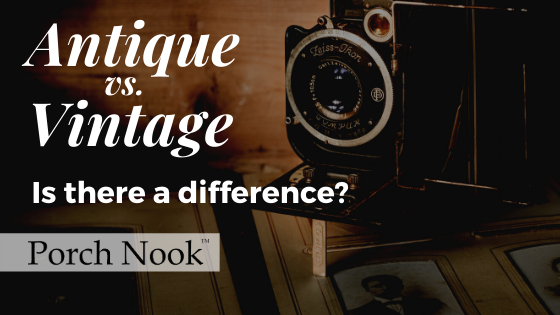
Antique vs. Vintage - Is There a Difference?

For the sake of transparency, I am not an antiquities dealer, nor do I specialize in antiques. However, for many years I've gained experience acquiring and selling old stuff, and hung around a lot of people who also like to acquire and sell old stuff. I gotta tell'ya, they're my kind of people...smart, creative, not shy and will tell you what's what.
There was a time in my life, I admit it, when I called anything old "antique". Unfortunately, my lesson was delivered to me via public shamming on Facebook. I listed on a buy/sell group an upcylced painted end table manufactured in the 1940s. In comments a gentleman, who claimed to be an antiquities dealer, accused me of false advertising and called for group banishment. I was mortified, embarrassed, angry, confused...and now my reputation and integrity was being questioned.
Here's the thing, Yes, his delivery and how he delivered it, was slanderous and unprofessional. However, he was right...and the best part is I learned from it! I'm now even BETTER at what I do AND by sharing this embarrassing experience I will save others from having their reputation questioned.

What's the #1 lesson I learned? The vast majority who post on Facebook, CraigsList, or are kind enough to put a garage sale together so you can rummage through their belongings, are NOT aware a difference between "antique" and "vintage" exists. Like me once, they are simply at a time in their life when they see something that looks old call it "antique".
- ANTIQUE: When buying or selling an item labeled "ANTIQUE", trade standards suggest that the term should be reserved only for items greater than 100 years old. Outside of the practice of buying and selling items, however, use of the word "ANTIQUE" can be understood to attach no specific age to an item. However, some hold to an 80 year marker. The 80 year marker considers the heritage of the item in that it reflects the span of two generations, with one generation traditionally considered to be the length of 40 years.
- VINTAGE: This term has several different accepted meanings and can cause confusion. The loosest meaning implies that the item is of a fashion that was popular in a different era. Used in this sense, "VINTAGE" may not mean that it was produced in that era, but simply that it mimics the fashions of that era. This can cause hard feelings because most people expect (and I'm one of them) that the term means something more.
- The common expectation of a "VINTAGE" item is to have a date or decade applied to it. Accordingly, most experts in the trade have decided that the term "VINTAGE" refers to items that are over 50 years old, but less than 100. This kind of standard works when dealing with truly old, but not antique, items. However, this falls short when using the term to describe something newer, and from a specific era.
- If an item is said to be “VINTAGE”, then it should technically state the year, decade, or era in which it was created.
Be kind, share the knowledge and happy hunting!!




2 comments
Thank you so much for explaining this difference, I have never been told quite so easy to understand but yet correctly, you did alot of people a great service
You are absolutely correct. The misuse of these terms sets my teeth grinding.